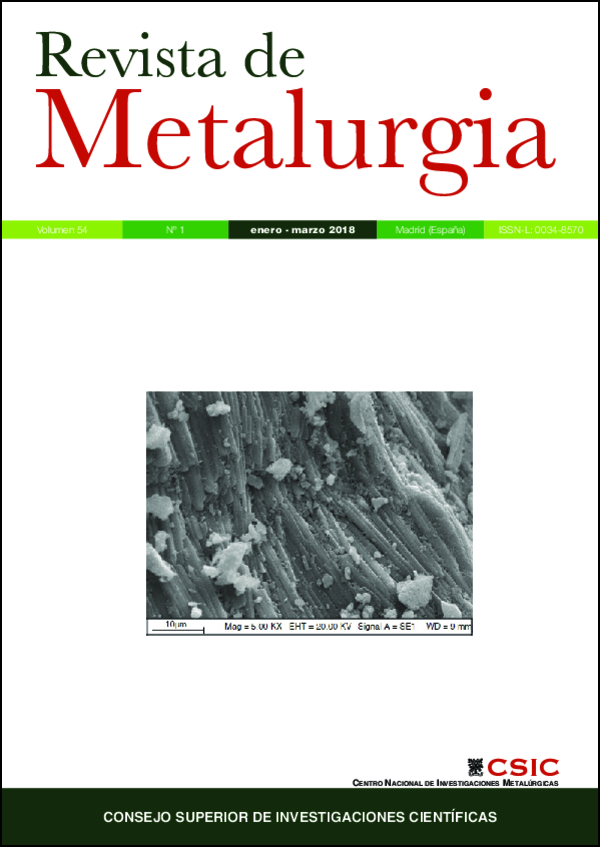Application of Rietveld Refinement to the correlation of the microstructure evolution of white cast irons with 18 and 25 %-wt. Cr after oil quench and successive temper treatments, with abrasive wear and bending testing
DOI:
https://doi.org/10.3989/revmetalm.113Keywords:
Abrasive wear, Flexural strength, High chromium white cast iron, Rietveld refinement, Secondary carbides, X-ray DiffractionAbstract
Through the application of Rietveld’s structural refinement method, the phases present in oil quenched and successively tempered treatments at 500 ºC of hypoeutectic white cast irons containing 18 and 25%-wt. Cr were identified. The former were correlated to the behavior shown under abrasive wear testing and bending testing too. The fraction of retained austenite after quenching for both highly alloyed irons was low. The alloy containing 18%-wt. Cr showed the highest fraction of carbides after quenching, and yet it was observed that secondary carbides seemed to develop preferentially in former destabilized proeutectic austenite as compared to former destabilized eutectic austenite. On the other hand, the highly alloyed cast iron with 25%-wt. Cr exhibited a more homogeneous phase resulting from austenite transformation after tempering. It was also observed that the cast iron containing 18%-wt. Cr showed partial solution of M7C3 carbides and a transformation of mixed secondary carbides of the M7C3 y M2C types. The fraction of martensite from quenching was detected to have a positive response to the resistance to abrasive wear, and illustrating of the inadequacy of quenching in oil for this sought property. The alloy bearing 25%-wt. Cr was found to have the highest martensite fraction after quenching, and thus a higher abrasive wear resistance. After a double tempering treatment, under bending testing, it displayed the highest rupture stress and strain, yielding a fragile fracture with facets of the transgranular mode. It was however observed the presence of regions depicting ductile fracture associated to double tempered martensite.
Downloads
References
ASTM G76 (2004). Standard Test Method for Conducting Erosion Tests by Solid Particle Impingement Using Gas Jets. ASTM International, West Conshohocken, PA, USA.
Bedolla-Jacuinde, A., Guerra, F.V., Mejía, I., Zuno-Silva, J., Maldonado, C. (2016). Boron effect on precipitation of secondary carbides during destabilization of high chromium white iron. Int. J. Cast. Metal. Res. 29 (1–2), 55–61. https://doi.org/10.1080/13640461.2016.1142236
Davis, J.R. (1994). ASM Specialty Handbook - Cast Irons. ASM International, Kinsman Road, Ohio, USA.
Efremenko, V., Shimizu, K., Chabak, Y. (2013). Effect of Destabilizing Heat Treatment on Solid-State Phase Transformation in High-Chromium Cast Irons. Metall. Mater. Trans. A. 44 (12), 5434–5446. https://doi.org/10.1007/s11661-013-1890-9
Fairhust, W., Rohrig, K. (1974). Abrasion resistant high chromium cast irons. Foundry Trade Journal 136, 685–698.
Fernández, I., Belzunce, F.J. (2006). Influencia de diversos tratamientos térmicos en la microestructura de una fundición blanca con alto contenido en cromo. Rev. Metal. 42 (4), 279–286.
Gasan, H., Ertuk, F. (2013). Effects of a destabilization heat treatment on the microstructure and abrasive wear behavior of high chromium white cast iron investigated using different characterization techniques. Metall. Mater. Trans. A. 44 (11), 4993–5005. https://doi.org/10.1007/s11661-013-1851-3
Hou, Q.Y., Huang, Z.Y., Wang, J.T. (2009). Application of rietveld refinement to investigate the high chromium white cast iron austempered at different temperatures. J. Iron Steel Res. Int. 16 (4), 33–38. https://doi.org/10.1016/S1006-706X(09)60057-1
Inthidech, S., Sricharoenchai, P., Matsubara, Y. (2012). Effect of molybdenum content on subcritical heat treatment behaviour of hypoeutectic 16 and 26 wt-% chromium cast irons. Int. J. Cast. Metal. Res. 25 (5), 257–263. https://doi.org/10.1179/1743133612Y.0000000009
Opapaiboon, J., Sricharoenchai, P., Inthidech, S., Matsubara, Y. (2015). Effect of carbon content on heat treatment behavior of multi-alloyed white cast iron for abrasive wear resistance. Mater. Trans. 56 (5), 720–725. https://doi.org/10.2320/matertrans.M2015001
Pero-Sanz, J.A. (1994). Materiales para Ingeniería. Fundiciones Férreas. Editor Dossat, Madrid.
Powell, G.L.F., Bee, J.V. (1996). Secondary carbide precipitation in an 18 wt% Cr-1 wt% Mo white iron. J. Mater. Sci. 31 (3), 707–711. https://doi.org/10.1007/BF00367889
Scandian, C., Boher, C., de Mello, J.D.B., Rezai-Aria, F. (2009). Effect of molybdenum and chromium contents in sliding wear of high-chromium white cast iron: The relationship between microstructure and wear. Wear 267 (1–4), 401–408. https://doi.org/10.1016/j.wear.2008.12.095
Tenorio, J.A.S., Albertin, E., Espinosa, D.C.R. (2000). Effects of Mo additions on the solidification of high chromium cast iron. Int. J. Cast. Metal. Res. 13 (2), 99–105. https://doi.org/10.1080/13640461.2000.11819393
Wang, J., Zuo, R.L., Sun, Z.P., Li, C., Liu, H.H., Yang, H.S., Shen, B.L., Huang, S.J. (2005). Influence of secondary carbides precipitation and transformation on hardening behavior of a 15 Cr-1 Mo-1.5V white iron. Mater. Charact. 55 (3), 234–240. https://doi.org/10.1016/j.matchar.2005.06.002
Wang, J., Sun, Z., Shen, B., Gao, S., Zuo, R., Li, C., Huang, S. (2006). Effects of secondary carbide precipitation and transformation on abrasion resistance of the 16Cr-1Mo-1Cu white iron. J. Mater. Eng. Perform. 15 (3), 316–319. https://doi.org/10.1361/105994906X108602
Wiengmoon, A., Pearce, J.T.H., Chairuangsri, T. (2011). Relationship between microstructure, hardness and corrosión resistance in 20 wt.%Cr, 27 wt.%Cr and 36 wt.%Cr high chromium cast irons. Mater. Chem. Phys. 125 (3), 739–748. https://doi.org/10.1016/j.matchemphys.2010.09.064
Published
How to Cite
Issue
Section
License
Copyright (c) 2018 Consejo Superior de Investigaciones Científicas (CSIC)

This work is licensed under a Creative Commons Attribution 4.0 International License.
© CSIC. Manuscripts published in both the printed and online versions of this Journal are the property of Consejo Superior de Investigaciones Científicas, and quoting this source is a requirement for any partial or full reproduction.All contents of this electronic edition, except where otherwise noted, are distributed under a “Creative Commons Attribution 4.0 International” (CC BY 4.0) License. You may read here the basic information and the legal text of the license. The indication of the CC BY 4.0 License must be expressly stated in this way when necessary.
Self-archiving in repositories, personal webpages or similar, of any version other than the published by the Editor, is not allowed.


















